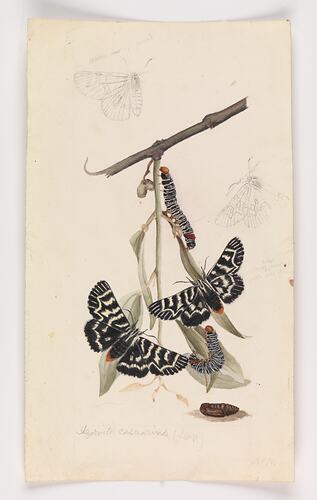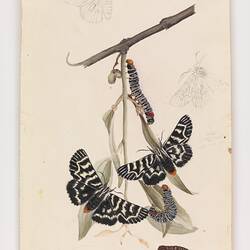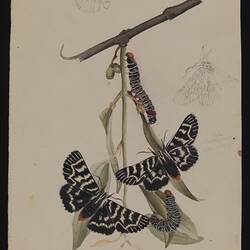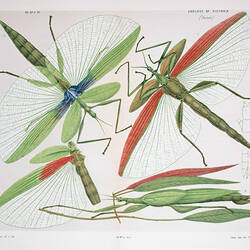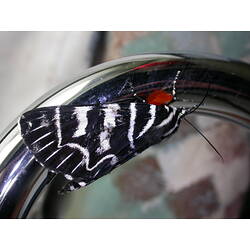Summary
Watercolour and pencil illustration (D4) of the life stages of a Mistletoe Moth, Comocrus behri, by Arthur Bartholomew in 1865. This work was commissioned by Frederick McCoy, the first Director of The National Museum of Victoria, for Plate 8 in 'The Prodromus of the Zoology of Victoria; Figures and descriptions of the living species of all classes of the Victoria indigenous animals'. McCoy referred to this species as Agaristes casuarinae, The Loranthus Day-moth.
Bartholomew's illustration forms part of the much larger Prodromus Collection. Many of the original illustrations in the collection informed the production of the two volume work The Prodromus of the Zoology of Victoria which was the first major publication of the National Museum of Victoria.
Bartholomew was originally hired as McCoy's attendant at the University. However, McCoy obviously saw his potential for the ambitious projects which lay ahead and he soon began both a zoological and geology series for McCoy which would form the basis of the Prodromus of the Zoology of Victoria and Prodromus of the Palaeontology of Victoria. During the following four decades he illustrated more than 700 zoological specimens, along with fossil and geological specimens. Having trained as a lithographer, Bartholomew also transferred many illustrations, both his own and those of other artists, onto stone for the production of lithographs. He also produced diagrams for the medical school at the University.
The Prodromus project followed a popular formula of the time, seeking to identify and classify the natural wonders of the 'new world'. Such publications reached a peak in popularity with the work of John Gould in England and the earlier work of James Audobon in America. In Australia, many professional and amateur publications, including Aldine's systematic studies of the colonies and Louise Anne Meredith's Bush Friends From Tasmania, contributed to the genre.
The publication of the Prodromus was an enormous undertaking, utilising the work of numerous artists, collectors, lithographers and publishers, over an extended period of time. Although costly in both financial and professional terms, it was met with critical acclaim and wide popular support. Financial battles were waged and lost by McCoy, but ultimately the Prodromus has stood the test of time and remains one of the Museums finest publications. McCoy died without completing his systematic study, but even at the time few believed that 'any of us will live to witness the completion of the work, if the entire Fauna of Victoria is to be illustrated.'
Description of Content
Vine moth, Comocrus behri (Angas) by Arthur Bartholomew. Drawing, pencil, watercolour, ink and varnish on paper, 27cm x 16cm. Drawing for Plate 8 in The Prodromus of the Zoology of Victoria by Frederick McCoy.
More Information
-
Collection Names
-
Collecting Areas
-
Publisher
-
Artist
-
Medium
Illustration - Pencil, watercolour, ink and varnish on paper
-
Technique
Scientific illustration
-
Plate Number
8
-
Drawing Number
4
-
State
Illustration
-
Primary Inscriptions
No IV / Upper view of female / new line / Upper wing (male)
-
Tertiary Inscriptions
Agarista casuarinae
-
Classification
-
Taxon Name
-
Author and date of publication
(Angas, 1847)
-
Preferred Common name
Mistletoe Moth
-
Kingdom
-
Phylum
-
Subphylum
-
Class
-
Order
-
Family
-
Genus
-
Species Name
behri
-
Category
-
Discipline
-
Type of item
-
Overall Dimensions
16 cm (Width), 27 cm (Height)
-
References
[Article] Yen, Alan L., et al. 2001. McCoy's Prodromus of the Zoology of Victoria: an unfinished task. Vic. Nat. 118 (6): 242-255.
[Book Series] McCoy, Frederick. 1878-1890. Natural History of Victoria: Prodromus of the Zoology of Victoria or Figures and Descriptions of the Living Species of All Classes of the Victorian Indigenous Animals. 1-2.
